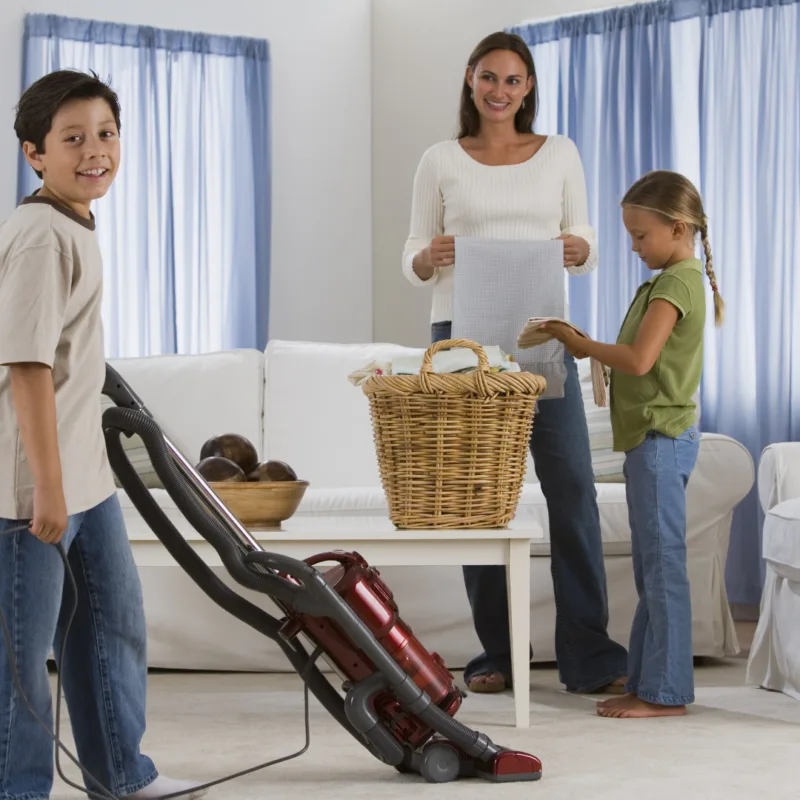Chores are a fact of life. But the truth is that kids love to help out around the house. Work and concentration bring children joy, according to Dr. Montessori, and I believe it. They enjoy feeling like they’re contributing to the family and getting things done.

Plus, it’s a great way to teach them responsibility. But sometimes, getting everyone on board with chores can be challenging. Here are some tips for how to get your whole family help with chores.
But don’t worry, we’ve got some tips to make getting your whole family pitching in a breeze. So read on and get ready to put those pint-sized helpers to work!
Chores can be an exhausting part of life. In some households, one parent stays at home with the kids and does everything from dishes to laundry while their partner works outside.
In other homes, both parents do their business throughout the day without help. Yup, everything from cooking meals or doing errands. So, there’s no time left over for family time or self-care.

How to Get Your Whole Family Helping with Chores
When your kids are babies and toddlers, it’s taken for granted that you, as the parent, will do everything for them. Indeed, even as toddlers grow to the stage where they love to help, their help is often brushed off because they aren’t big enough to “do it right.”
Admittedly, cooking with small kids can be challenging. Kids spill things, don’t know how to crack eggs properly, stir things so fast that batter sloshes over the bowl, or try to taste something before they’re cooked. But they’re learning, and having patients is critical during these moments.
Why Household Chores are Important
We are tempted to think that because children may cause more mess, it’s easier to do it ourselves.
The problem with thinking oh, it’s easier to do it myself is that eventually, your kids will agree with you. They’ll get older, less interested in helping out, and more interested in what they enjoy.
They get busy with school and myriad extracurriculars, and before you know it, they’re graduating and never learned how to do laundry or cook anything more complicated than toast.
In the meantime, you’ve grown resentful of doing everything for everyone, and your partner is oblivious to the four million tasks that hum along without anyone noticing but you. Doing chores teaches kids essential life skills, independence, and responsibility.
Plus, eventually, every family member participating in chores will keep your house clean! I promise.

Mom rage may not have a clinical diagnosis, but most moms recognize it. When moms feel stressed about taking care of everything, when they feel like they don’t have help from the people that supposedly love them the most, rage can be powerful.
Many moms go out to work, but decades-old notions of moms persist. You know, the kind with moms cooking, cleaning, running errands, and taking care of the children while dad earns a living. Many families no longer work that way, so everyone should share the home labor.
When the family doesn’t pitch in, many moms will eventually demand help, disguised as exploding into a raging tantrum that leaves the family saying, gee, what’s the matter with her?
Why A Household Chore List is Helpful
So, how do you get everyone in the house to contribute? First, sit down with your family and calmly explain the situation. (For the record, stay-at-home parents should feel free to do this.
The general idea is that in this day and age, there shouldn’t be one person in charge of ensuring everything gets done. If you live in a house, you are responsible for taking care of it. End of story.)

Explain that everyone needs to contribute for peace to be maintained. Every family is different, so you need to brainstorm what chores everyone can do and how much you need to be taken off your plate.
Results will vary, of course. It’s safe to say that your family won’t leap to take chores off your plate, but one thing to try is a family chore list. Depending on your household, this can be a daily or weekly chore list.
Daily chores include wiping down countertops and picking up shared spaces. Weekly chores may include taking out the trash, helping with recycling, and cleaning the bathroom.
How to Create a Household Chore List
One way to decide is to count up major chores you need to be done often and compare them to the number of people in your home. If you come up with eight such house chores with four people in the house, you probably want a daily list.
A weekly list will be more manageable if you come up with fifty tasks. Then assign tasks to family members. Have fun and personalize the chore lists for each family member.
Your list can be written on a whiteboard, a piece of scrap paper, or in a notebook. Some chores you might include could be making dinner, doing dishes, vacuuming, wiping down the stove and counters, pet care, taking out trash or recycling, washing and folding laundry, or cleaning a bathroom.
It depends, of course, on how old your children are, but school-aged children can generally do more than we give them credit for. They can learn to do any of the chores mentioned above with guidance.

Once the list is complete, it’s open for signup. Be prepared for a stampede to get preferred jobs. If a child (or adult) is scooping more than their share of simple tasks, you can institute a star rating, where the most straightforward chores are starred, and each person is only eligible to pick one or two.
A weekly list might have 2- or 3-star chores, but in the end, what’s important is that everyone pitches in, work together, and gets it all done, with no Mom tantrums necessary.
Note that rewards and allowances should not apply here. The entire point is that one person should not have to do everything. If you live in a home, help take care of it. Institute this system to hold everyone to this standard and structure allowances another way.
This will keep mom from exploding and keep the house tidy. And everyone knows that when mom is happy, everyone’s happy!

